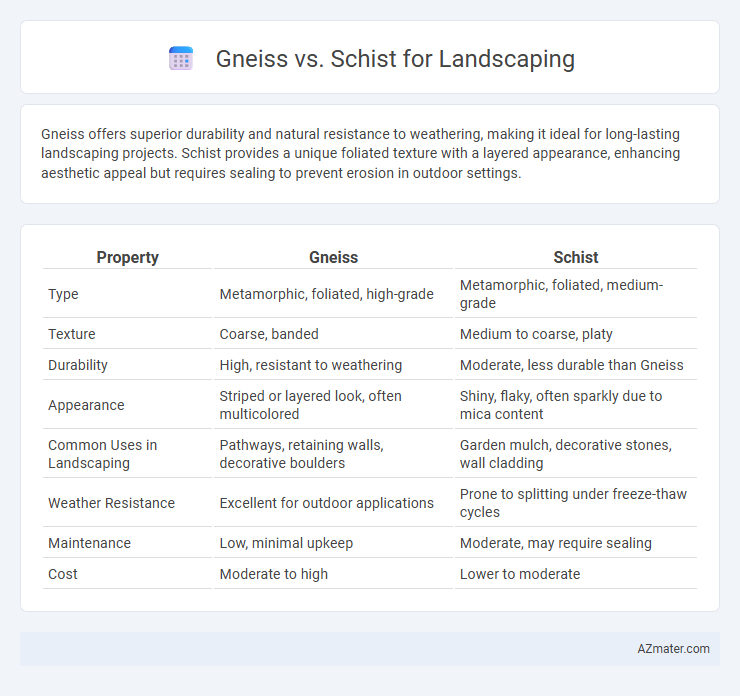Gneiss offers superior durability and natural resistance to weathering, making it ideal for long-lasting landscaping projects. Schist provides a unique foliated texture with a layered appearance, enhancing aesthetic appeal but requires sealing to prevent erosion in outdoor settings.
Table of Comparison
| Property | Gneiss | Schist |
|---|---|---|
| Type | Metamorphic, foliated, high-grade | Metamorphic, foliated, medium-grade |
| Texture | Coarse, banded | Medium to coarse, platy |
| Durability | High, resistant to weathering | Moderate, less durable than Gneiss |
| Appearance | Striped or layered look, often multicolored | Shiny, flaky, often sparkly due to mica content |
| Common Uses in Landscaping | Pathways, retaining walls, decorative boulders | Garden mulch, decorative stones, wall cladding |
| Weather Resistance | Excellent for outdoor applications | Prone to splitting under freeze-thaw cycles |
| Maintenance | Low, minimal upkeep | Moderate, may require sealing |
| Cost | Moderate to high | Lower to moderate |
Introduction to Gneiss and Schist
Gneiss and schist are metamorphic rocks commonly used in landscaping for their unique textures and durability. Gneiss features distinct banding and a coarse-grained texture rich in quartz, feldspar, and mica, making it ideal for creating dramatic visual effects in garden paths and retaining walls. Schist, characterized by its foliated, layered structure with abundant mica flakes, offers a shiny, reflective surface that enhances garden aesthetics with natural shimmer and is suitable for decorative rock features.
Geological Formation and Composition
Gneiss, formed through high-grade regional metamorphism, features a banded texture resulting from the recrystallization of feldspar, quartz, and mica minerals under intense heat and pressure. Schist, characterized by its foliated structure, develops from medium to high-grade metamorphic processes that align platy minerals such as chlorite, mica, and talc. The mineral composition of gneiss provides greater durability and resistance to weathering, making it ideal for robust landscaping projects, while schist's pronounced foliation offers aesthetic appeal with its layered texture but may be less durable in exposed environments.
Visual Appearance and Texture Comparison
Gneiss exhibits a banded or foliated texture with alternating light and dark mineral layers, creating a visually striking, striped appearance ideal for modern landscaping designs. Schist features a more crystalline and flaky texture, with visible mica flakes that add a shimmering, reflective quality, enhancing natural garden aesthetics. Both stones offer unique surface textures, with gneiss providing a smoother, layered look and schist delivering a rougher, sparkly finish perfect for rustic or organic landscapes.
Durability and Weather Resistance
Gneiss offers superior durability and excellent weather resistance, making it ideal for long-lasting landscaping applications exposed to harsh climates. Schist, while visually appealing with its layered texture, tends to be less durable and more prone to weathering and erosion over time. For projects requiring extreme resilience against freeze-thaw cycles and moisture, gneiss provides a more robust and stable option.
Workability in Landscaping Projects
Gneiss offers high durability and a coarse texture, making it ideal for structural landscaping elements like retaining walls and pathways that require strength and stability. Schist's foliated structure allows for easier splitting and shaping, providing superior workability for decorative features such as garden edging or stepping stones. Choosing between gneiss and schist depends on the specific landscaping project demands, balancing gneiss's toughness with schist's ease of manipulation.
Color Variations and Aesthetic Appeal
Gneiss offers a diverse range of color variations, from subtle grays and whites to bold pinks and reds, providing a natural, elegant appearance for landscaping projects. Schist features a more metallic and sparkly texture due to its mica content, giving landscapes a shimmering effect with colors ranging from silver and gray to green and purple. The aesthetic appeal of gneiss lies in its banded and layered look, while schist is prized for its reflective surface and rich color depth, making both ideal for enhancing outdoor spaces with distinct visual textures.
Cost and Availability
Gneiss and schist are popular choices for landscaping due to their durability and aesthetic appeal, but gneiss generally commands a higher price due to its denser composition and polished finish options. Availability varies by region; gneiss is often more accessible in areas with significant metamorphic rock formations, while schist can be more abundant in locations with higher mica content. Choosing between gneiss and schist depends largely on budget constraints and local quarry options, with schist typically offering a more cost-effective and readily available solution for landscaping projects.
Applications in Landscaping Design
Gneiss and schist offer distinct advantages in landscaping design, with gneiss providing durability and a visually striking foliated texture ideal for retaining walls, pathways, and decorative rock features. Schist's layered, flaky structure and natural sheen enhance garden beds, water features, and accent pieces, creating a rustic, elegant appearance. Both stones withstand weathering well, but gneiss is preferred for structural applications due to its hardness, while schist excels in aesthetic and softer landscaping designs.
Environmental Impact and Sustainability
Gneiss and schist both offer durable options for landscaping with low environmental impact due to their natural formation and longevity, reducing the need for frequent replacement. Gneiss typically has a higher density and slower weathering rate, which contributes to greater durability and less frequent quarrying, enhancing sustainability. Schist's foliated structure allows for easier splitting and shaping, often resulting in less waste during processing and making it a sustainable choice for projects prioritizing material efficiency.
Choosing the Right Stone for Your Landscape
Gneiss offers durability and a coarse, banded texture that enhances rugged landscape designs, making it ideal for pathways, retaining walls, and decorative rock features. Schist features a foliated structure with a shiny, layered appearance that adds visual interest and works well in garden borders, rock gardens, and as accent stones. Selecting between gneiss and schist depends on the desired aesthetic, structural strength, and weather resistance required for your specific landscaping project.

Infographic: Gneiss vs Schist for Landscaping
 azmater.com
azmater.com